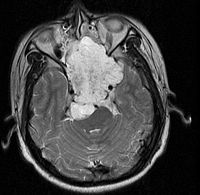
Photo from wikipedia
Background Chordomas are rare, slow-growing, locally aggressive, malignant tumors of the spine. Chordomas are conventionally treated with surgical resection with or without radiation. There is an absence of literature documenting… Click to show full abstract
Background Chordomas are rare, slow-growing, locally aggressive, malignant tumors of the spine. Chordomas are conventionally treated with surgical resection with or without radiation. There is an absence of literature documenting the natural history of a primary sacral chordoma. Case Description A 65-year-old man presented with rectal pain, constipation, urinary and fecal incontinence, S1 radiculopathy, and a palpable rectal mass. A needle biopsy confirmed the pathologic diagnosis of sacral chordoma. The patient declined to have surgery because of the surgical risks involved. He was managed conservatively with supportive care only. The patient was routinely followed in clinic and had a subjective and objective excellent quality of life with adequate pain management. Meanwhile, his neurologic status did not deteriorate. During follow-up, some posterolateral aspects of the chordoma regressed. However, the bulk of the lesion continued to slowly progress. The patient survived for 7.5 years. He eventually succumbed to urosepsis and new-onset peritoneal metastasis. Conclusions To our knowledge, the patient is the only documented case in the literature of an untreated biopsy-proven sacral chordoma. The patient's tumor was intended for resection, and therefore comparable with data from treated chordomas. The patient's survival is similar to the median survival in treated chordomas. The patient's survival was despite negative prognosticators, such as advanced age of the patient and high sacral location above S2.
Journal Title: World neurosurgery
Year Published: 2020
Link to full text (if available)
Share on Social Media: Sign Up to like & get
recommendations!